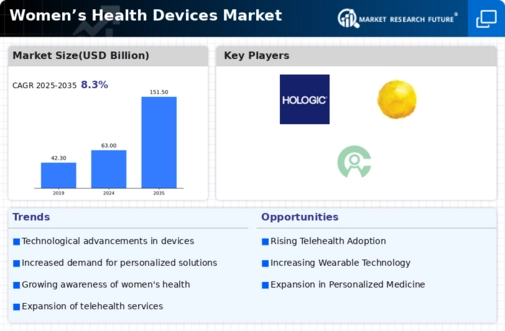Leading market players are investing heavily in research and development to expand their product lines, which will help the Women’s Health Devices market, grow even more. Market participants are also undertaking a variety of strategic activities to expand their global footprint, with important market developments including new product launches, contractual agreements, mergers and acquisitions, higher investments, and collaboration with other organizations. To expand and survive in a more competitive and rising market climate, the Women’s Health Devices industry must offer cost-effective items.
Manufacturing locally to minimize operational costs is one of the key business tactics used by manufacturers in the global Women’s Health Devices industry to benefit clients and increase the market sector. In recent years, the Women’s Health Devices industry has offered some of the most significant advantages to the field of healthcare and the well-being of women. Major players in the Women’s Health Devices Market, including Coloplast A/S (Denmark), Hologic Inc. (U.S.), Boston Scientific Corporation (U.S.), ALLERGAN (AbbVie, Inc.) (U.S.), BD (Becton, Dickinson, and Company) (U.S.), F.
Hoffmann-La Roche Ltd (Switzerland), CooperSurgical Inc. (The Cooper Companies, Inc.) (U.S.), Caldera Medical (U.S.), Reckitt Benckiser Group PLC (U.K.) are attempting to increase market demand by investing in research and development operations.
Coloplast A/S is a leading manufacturer and provider of a wide range of healthcare products and services. Their product portfolio covers ostomy care, respiratory solutions, urology care, continence care, and skin and wound care. This encompasses various essential items such as urisheaths, ostomy bags, catheters, anal irrigation systems, sling products, advanced dressings for wound care and skin protection, cleansers, moisturizers, skin protectants, anti-fungal products, and hand cleansers. The company markets its products under multiple brand names, including SenSura, SpeediCath, Persiteen, Biatain, Conveen, InterDry, Brava, and Comfeel.
Coloplast distributes its products through subsidiary companies and a network of distributors, reaching healthcare facilities, wholesalers, retailers, and institutions across Europe, Africa, South America, the UAE, Singapore, Asia, Russia, Australia, and North America. Coloplast's headquarters are situated in Humlebaek, Denmark.
Hoffmann-La Roche Ltd is a prominent biotechnology firm specializing in the development of drugs and diagnostic solutions for the treatment of major diseases. The company's extensive product portfolio includes medications for cancer treatment, various auto-immune conditions, central nervous system disorders, ophthalmological issues, infectious diseases, and respiratory ailments. Additionally, Roche offers in vitro diagnostics, tissue-based cancer diagnostics, and diabetes management solutions. Roche is dedicated to research aimed at discovering innovative approaches to disease prevention, diagnosis, and treatment. Its products and services are made available to a diverse clientele, including hospitals, healthcare professionals, commercial laboratories, researchers, and pharmacists.
The company operates in numerous countries worldwide, in collaboration with its subsidiaries and partners. Roche is headquartered in Basel, Switzerland. In December 2021, the company introduced the PIK3CA Mutation Test, serving breast cancer patients in regions where the CE mark is recognized, thereby offering a valuable diagnostic option.















Leave a Comment